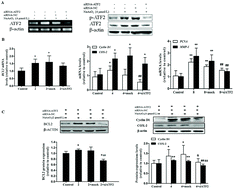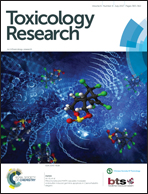ATF2 partly mediated the expressions of proliferative factors and inhibited pro-inflammatory factors’ secretion in arsenite-treated human uroepithelial cells
Abstract
Inorganic arsenic (iAs) could induce the expression of activating transcription factor-2 (ATF2) in the human urinary bladder epithelial cell line (SV-HUC-1 cells). ATF2, as a member of the bZIP transcription factor family, has been implicated in a transcriptional response leading to cell growth, migration and malignant tumor progression. However, little is known about the effects of ATF2 on proliferative factors in iAs treated human urothelial cells. In this study, ATF2 siRNA was employed to investigate the relationship between ATF2 activation and the expressions of proliferative factors, such as BCL2, cyclin D1, COX-2, MMP1 and PCNA, and pro-inflammatory factors (TNFα, TGFα and IL-8) in SV-HUC-1 cells. The results showed that low concentration arsenite increased the expressions of proliferative factors BCL2, cyclin D1, COX-2, MMP1 and PCNA in SV-HUC-1 cells, and ATF2 siRNA partly decreased the expressions of BCL2, cyclin D1, and COX-2. A neutralizing antibody of IL-8 was used for attenuating the levels of IL-8 and neutralizing antibody of IL-8 did not relieve the expressions of ATF2 and proliferative factors induced by arsenite in SV-HUC-1 cells. In addition, ATF2 knockdown did not decrease the expressions of pro-inflammatory cytokines induced by arsenite in SV-HUC-1 cells, but dramatically increased mRNA expressions of TNFα, TGFα and IL-8 under arsenite and non-arsenite conditions. In conclusion, our present study indicated that ATF2, but not IL-8, played a partial role in the expressions of proliferative factors induced by arsenite in human uroepithelial cells.



 Please wait while we load your content...
Please wait while we load your content...